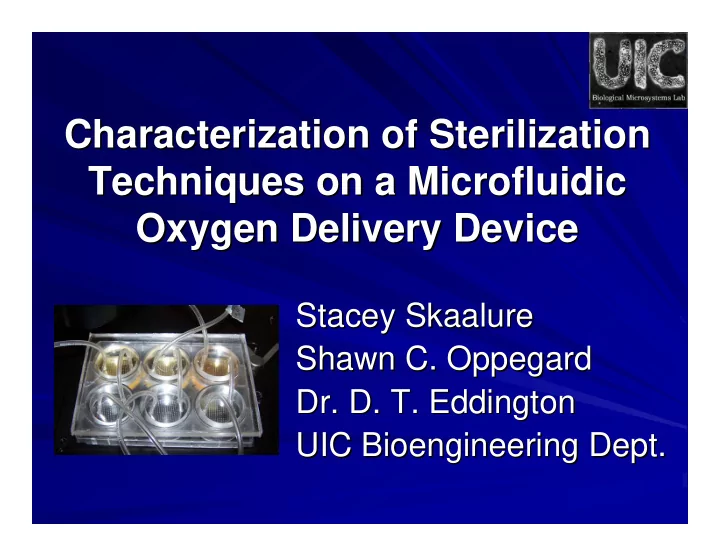

Characterization of Sterilization Characterization of Sterilization Techniques on a Microfluidic Microfluidic Techniques on a Oxygen Delivery Device Oxygen Delivery Device Stacey Skaalure Skaalure Stacey Shawn C. Oppegard Oppegard Shawn C. Dr. D. T. Eddington Eddington Dr. D. T. UIC Bioengineering Dept. UIC Bioengineering Dept.
Objectives Objectives General: Validate utility of microfluidic microfluidic General: Validate utility of device fabricated in lab device fabricated in lab – Designed to carefully and efficiently control Designed to carefully and efficiently control – oxygen exposure to cell cultures oxygen exposure to cell cultures Specific: Characterize effects of Specific: Characterize effects of sterilization methods on effectiveness of methods on effectiveness of sterilization the device the device
Motivation: Why control Motivation: Why control oxygen content in cell culture? oxygen content in cell culture? Simulate hypoxia and Simulate hypoxia and hyperoxia in vitro in vitro hyperoxia Some experimental Some experimental applications: applications: – Response of cardiac Response of cardiac – cells to changing cells to changing oxygen levels (eg eg. . oxygen levels ( heart attack) heart attack) – Regulation of stem cell Regulation of stem cell www.aist.go.jp/aist_e/aist_today/2006_22/feature/feature_06.html – differentiation using differentiation using oxygen signals oxygen signals
Problem: Limitations of existing Problem: Limitations of existing exposure system exposure system Modular hypoxic chamber Modular hypoxic chamber – Floods entire chamber with Floods entire chamber with – gas gas – All cells exposed to same All cells exposed to same – oxygen concentration oxygen concentration – Takes >3 h to equilibrate Takes >3 h to equilibrate – with media with media
Advantages of microfluidic microfluidic Advantages of exposure system exposure system Microfluidic oxygen oxygen Microfluidic delivery device delivery device – Adapts to multi Adapts to multi- -well culture well culture – plates plates – Can expose cells in Can expose cells in – different wells or same different wells or same well to different O 2 well to different O 2 concentrations concentrations www.sumibe.co.jp/sumilon/photo/plate1.jpg – System equilibrates in System equilibrates in – minutes minutes – Made with PDMS: Made with PDMS: biocompatible, gas-permeable –
Structure of the device Structure of the device
Device sterilization analysis Device sterilization analysis Devices must be Devices must be sterilized before use in sterilized before use in cell culture cell culture Need to investigate: : Need to investigate – Optimal sterilization Optimal sterilization – technique that withstands technique that withstands repetitive use repetitive use Experimental Plan: Experimental Plan: – Cut up device into 5 separate inserts, one per Cut up device into 5 separate inserts, one per – sterilization technique sterilization technique – Repeatedly sterilize and measure oxygen Repeatedly sterilize and measure oxygen – permeability through membranes permeability through membranes
Sterilization Techniques Sterilization Techniques UV light 2 hours in culture hood 15 min at 121ºC Autoclave 15 min soak at 52ºC 15 min soak 70% Ethanol Control - Nothing
Measurement setup Measurement setup Device FOXY-SGS slide Generate Generate 5 images taken calibration curve calibration curve per slide using using 6-well plate 0, 10, 20% O 2 0, 10, 20% O 2 flowing through flowing through a device without a device without Plastic tubing membrane membrane Test Test Fluorescent microscope experimental experimental devices using devices using Flowmeter 10% O 2 10% O 2 Devices in 6- well plate Oxygen tank
Measuring oxygen concentration Measuring oxygen concentration with fluorescent microscopy with fluorescent microscopy Imaging software can Imaging software can Calibration Curve measure fluorescent measure fluorescent 4000 intensity intensity 3500 3000 y = 53167x 2 - 21603x + 3499.3 Intensity and [O 2 ] are Intensity and [O 2 ] are 2500 Intensity 2000 inversely related inversely related 1500 1000 Calibration curve Calibration curve 500 0 used to solve for [O 2 ] used to solve for [O 2 ] 0% 5% 10% 15% 20% 25% [O2] sensed in test sensed in test devices devices
Effects of sterilization on diffusion Effects of sterilization on diffusion * of 10% oxygen of 10% oxygen 12 * n = 5 10 8 [O2] (%) 6 Autoclave 4 Dri-Clean Ethanol 2 UV Control 0 0 5 10 15 20 25 30 35 Cycle
Conclusions Conclusions All of sterilized devices performed same as control All of sterilized devices performed same as control – (2 (2- -factor ANOVA, p > 0.5) factor ANOVA, p > 0.5) – – No negative effects due to sterilization techniques No negative effects due to sterilization techniques – – User can choose preferred technique User can choose preferred technique – No significant changes seen due to repetitive No significant changes seen due to repetitive sterilization sterilization – (2 (2- -factor ANOVA, p > 0.4) factor ANOVA, p > 0.4) – – Can be used/sterilized many more than 32 times before Can be used/sterilized many more than 32 times before – replacement may be necessary replacement may be necessary Overall: Device very resistant to changes in Device very resistant to changes in Overall: permeability properties permeability properties
Ongoing/future goals Ongoing/future goals ACE + + Develop computer models using CFD- -ACE Develop computer models using CFD – Simulate fluid dynamics and diffusion within Simulate fluid dynamics and diffusion within – device device – Serves as a form of validation Serves as a form of validation – Conduct mesenchymal mesenchymal stem cell studies stem cell studies Conduct – Control differentiation by exposing cells to Control differentiation by exposing cells to – various oxygen concentrations various oxygen concentrations Publish paper, recommend device to Publish paper, recommend device to potential users potential users
Acknowledgements Acknowledgements Shawn C. Oppegard Oppegard Shawn C. Ki- -Hwan Nam Hwan Nam Ki Dr. David Eddington Eddington Dr. David Dr. Takoudis Takoudis Dr. Dr. Jursich Jursich Dr. NSF and DoD DoD Grant Grant NSF and NSF- -EEC 0755115 EEC 0755115 NSF
Recommend
More recommend